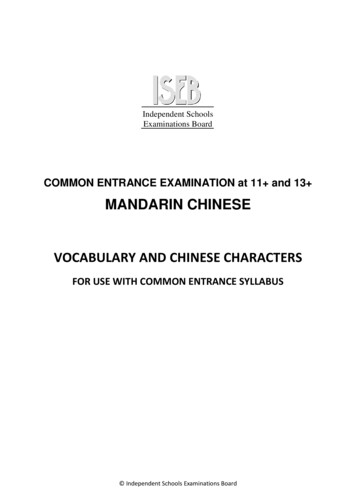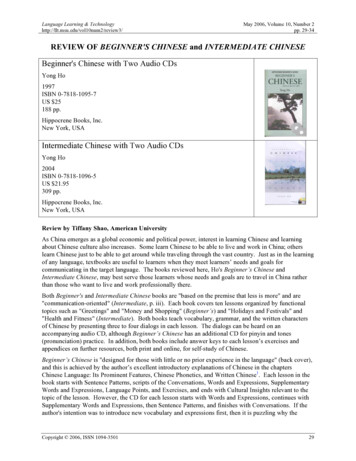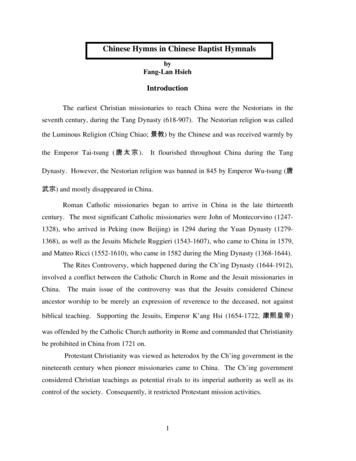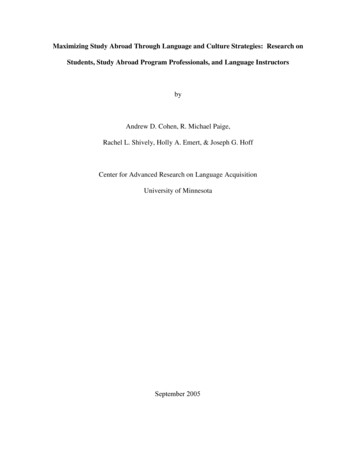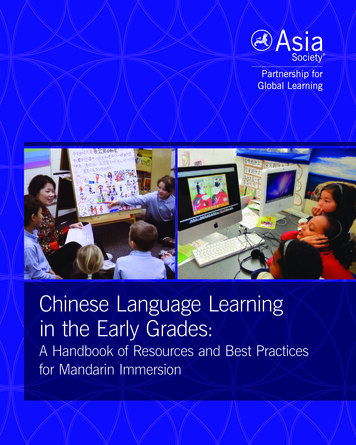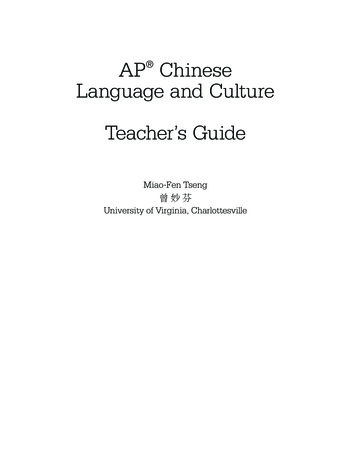
Transcription
AP ChineseLanguage and CultureTeacher’s GuideMiao-Fen Tseng曾妙芬University of Virginia, Charlottesville
The College Board: Connecting Students to College SuccessThe College Board is a not-for-profit membership association whose mission is to connect studentsto college success and opportunity. Founded in 1900, the association is composed of more than 5,000schools, colleges, universities, and other educational organizations. Each year, the College Board servesseven million students and their parents, 23,000 high schools, and 3,500 colleges through major programsand services in college admissions, guidance, assessment, financial aid, enrollment, and teaching andlearning. Among its best-known programs are the SAT , the PSAT/NMSQT , and the Advanced PlacementProgram (AP ). The College Board is committed to the principles of excellence and equity, and thatcommitment is embodied in all of its programs, services, activities, and concerns.For further information, visit www.collegeboard.com. 2007 The College Board. All rights reserved. College Board, Advanced Placement Program, AP, APCentral, AP Vertical Teams, Pre-AP, SAT, and the acorn logo are registered trademarks of the CollegeBoard. AP Potential and connect to college success are trademarks owned by the College Board. PSAT/NMSQT is a registered trademark of the College Board and National Merit Scholarship Corporation. Allother products and services may be trademarks of their respective owners. Visit the College Board on theWeb: www.collegeboard.com.ii
ContentsWelcome Letter from the College Board. vEquity and Access.viiParticipating in the AP Course Audit.xiPreface.xiiChapter 1. About AP Chinese Language and Culture. 1Overview: Past, Present, Future. 1Course Description Essentials. 2Key Concepts and Skills. 3Chapter 2. Advice for AP Chinese Language and Culture Teachers. 8Preparing to Teach AP Chinese. 8Be an Effective Teacher. 9Immerse Students in Chinese. 10Make the Class Truly Communicative. 12Organizing Instructional Materials. 13Activities and Strategies for Building Proficiency. 15Assessment. 21Recruiting Chinese Learners. 23Implement an AP Chinese Vertical Team. 24Cultivating the AP Chinese Program. 24Chapter 3. How to Organize Your Course. 27Syllabus Development. 27Eight Sample Syllabi. 27Chapter 4. The AP Exam in Chinese Language and Culture. 127Exam Format. 128Preparing Students for the Exam. 133Scoring the Exam. 133Classroom Activities after the Exam. 135Chapter 5. Resources for Teachers. 136Teaching Resources. 136How to Address Limited Resources. 155Professional Development. 156iii
Welcome Letter from the College BoardDear AP Teacher:Whether you are a new AP teacher, using this AP Teacher’s Guide to assist in developing a syllabus for thefirst AP course you will ever teach, or an experienced AP teacher simply wanting to compare the teachingstrategies you use with those employed by other expert AP teachers, we are confident you will find thisresource valuable. We urge you to make good use of the ideas, advice, classroom strategies, and samplesyllabi contained in this Teacher’s Guide.You deserve tremendous credit for all that you do to fortify students for college success. The nurturingenvironment in which you help your students master a college-level curriculum—a much better atmospherefor one’s first exposure to college-level expectations than the often large classes in which many first-yearcollege courses are taught—seems to translate directly into lasting benefits as students head off to college.An array of research studies, from the classic 1999 U.S. Department of Education study Answers in theTool Box to new research from the University of Texas and the University of California, demonstratethat when students enter high school with equivalent academic abilities and socioeconomic status, thosewho develop the content knowledge to demonstrate college-level mastery of an AP Exam (a grade of 3or higher) have much higher rates of college completion and have higher grades in college. The 2005National Center for Educational Accountability (NCEA) study shows that students who take AP havemuch higher college graduation rates than students with the same academic abilities who do not havethat valuable AP experience in high school. Furthermore, a Trends in International Mathematics andScience Study (TIMSS, formerly known as the Third International Mathematics and Science Study) foundthat even AP Calculus students who score a 1 on the AP Exam are significantly outperforming otheradvanced mathematics students in the United States, and they compare favorably to students from thetop-performing nations in an international assessment of mathematics achievement. (Visit AP Central atapcentral.collegeboard.com for details about these and other AP-related studies.)For these reasons, the AP teacher plays a significant role in a student’s academic journey. Your APclassroom may be the only taste of college rigor your students will have before they enter higher education.It is important to note that such benefits cannot be demonstrated among AP courses that are AP courses inname only, rather than in quality of content. For AP courses to meaningfully prepare students for collegesuccess, courses must meet standards that enable students to replicate the content of the comparable collegeclass. Using this AP Teacher’s Guide is one of the keys to ensuring that your AP course is as good as (oreven better than) the course the student would otherwise be taking in college. While the AP Program doesnot mandate the use of any one syllabus or textbook and emphasizes that AP teachers should be grantedthe creativity and flexibility to develop their own curriculum, it is beneficial for AP teachers to comparetheir syllabi not just to the course outline in the official AP Course Description and in chapter 3 of thisguide, but also to the syllabi presented on AP Central, to ensure that each course labeled AP meets thestandards of a college-level course. Visit AP Central at apcentral.collegeboard.com for details about the APCourse Audit, course-specific Curricular Requirements, and how to submit your syllabus for AP CourseAudit authorization.As the Advanced Placement Program continues to experience tremendous growth in the twenty-firstcentury, it is heartening to see that in every U.S. state and the District of Columbia, a growing proportion
Welcome Letterof high school graduates have earned at least one grade of 3 or higher on an AP Exam. In some states, morethan 20 percent of graduating seniors have accomplished this goal. The incredible efforts of AP teachersare paying off, producing ever greater numbers of college-bound seniors who are prepared to succeed incollege. Please accept my admiration and congratulations for all that you are doing and achieving.Sincerely,Marcia WilburDirector, Curriculum and Content DevelopmentAdvanced Placement Programvi
Equity and AccessIn the following section, the College Board describes its commitment to achieving equity in the APProgram.Why are equitable preparation and inclusion important?Currently, 40 percent of students entering four-year colleges and universities and 63 percent of students attwo-year institutions require some remedial education. This is a significant concern because a student isless likely to obtain a bachelor’s degree if he or she has taken one or more remedial courses.1Nationwide, secondary school educators are increasingly committed not just to helping studentscomplete high school but also to helping them develop the habits of mind necessary for managing therigors of college. As Educational Leadership reported in 2004:The dramatic changes taking place in the U.S. economy jeopardize the economic future of studentswho leave high school without the problem-solving and communication skills essential to successin postsecondary education and in the growing number of high-paying jobs in the economy. Toback away from education reforms that help all students master these skills is to give up on thecommitment to equal opportunity for all.2Numerous research studies have shown that engaging a student in a rigorous high school curriculumsuch as is found in AP courses is one of the best ways that educators can help that student persistand complete a bachelor’s degree.3 However, while 57 percent of the class of 2004 in U.S. public highschools enrolled in higher education in fall 2004, only 13 percent had been boosted with a successful APexperience in high school.4 Although AP courses are not the only examples of rigorous curricula, thereis still a significant gap between students with college aspirations and students with adequate high schoolpreparation to fulfill those aspirations.Strong correlations exist between AP success and college success.5 Educators attest that this is partlybecause AP enables students to receive a taste of college while still in an environment that provides moresupport and resources for students than do typical college courses. Effective AP teachers work closelywith their students, giving them the opportunity to reason, analyze, and understand for themselves. As aresult, AP students frequently find themselves developing new confidence in their academic abilities anddiscovering their previously unknown capacities for college studies and academic success.1. Andrea Venezia, Michael W. Kirst, and Anthony L. Antonio, Betraying the College Dream: How Disconnected K–12 and PostsecondaryEducation Systems Undermine Student Aspirations (Palo Alto, Calif.: The Bridge Project, 2003), 8.2. Frank Levy and Richard J. Murnane, “Education and the Changing Job Market.” Educational Leadership 62 (2) (October 2004): 83.3. In addition to studies from University of California–Berkeley and the National Center for Educational Accountability (2005), see theclassic study on the subject of rigor and college persistence: Clifford Adelman, Answers in the Tool Box: Academic Intensity, AttendancePatterns, and Bachelor’s Degree Attainment (Washington, D.C.: U.S. Department of Education, 1999).4. Advanced Placement Report to the Nation (New York: College Board, 2005).5. Wayne Camara, “College Persistence, Graduation, and Remediation,” College Board Research Notes (RN-19) (New York: College Board,2003).vii
Equity and AccessWhich students should be encouraged to register for APcourses?Any student willing and ready to do the work should be considered for an AP course. The College Boardactively endorses the principles set forth in the following Equity Policy Statement and encourages schoolsto support this policy.The College Board and the Advanced Placement Program encourage teachers, AP Coordinators,and school administrators to make equitable access a guiding principle for their AP programs. TheCollege Board is committed to the principle that all students deserve an opportunity to participate inrigorous and academically challenging courses and programs. All students who are willing to acceptthe challenge of a rigorous academic curriculum should be considered for admission to AP courses.The Board encourages the elimination of barriers that restrict access to AP courses for students fromethnic, racial, and socioeconomic groups that have been traditionally underrepresented in the APProgram. Schools should make every e
AP Chinese Language and Culture Teacher’s Guide Miao-Fen Tseng 曾 妙 芬 University of Virginia, Charlottesville
